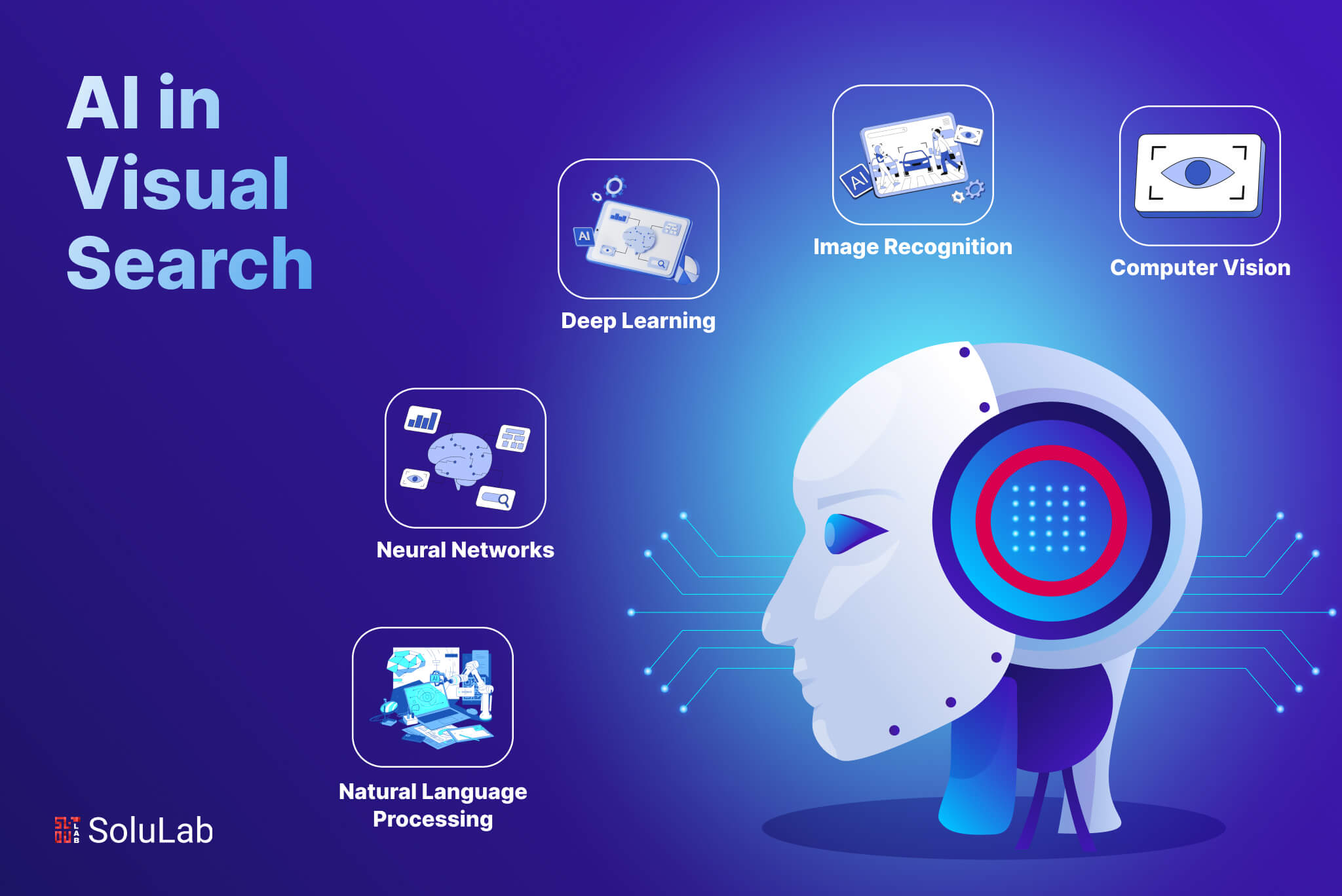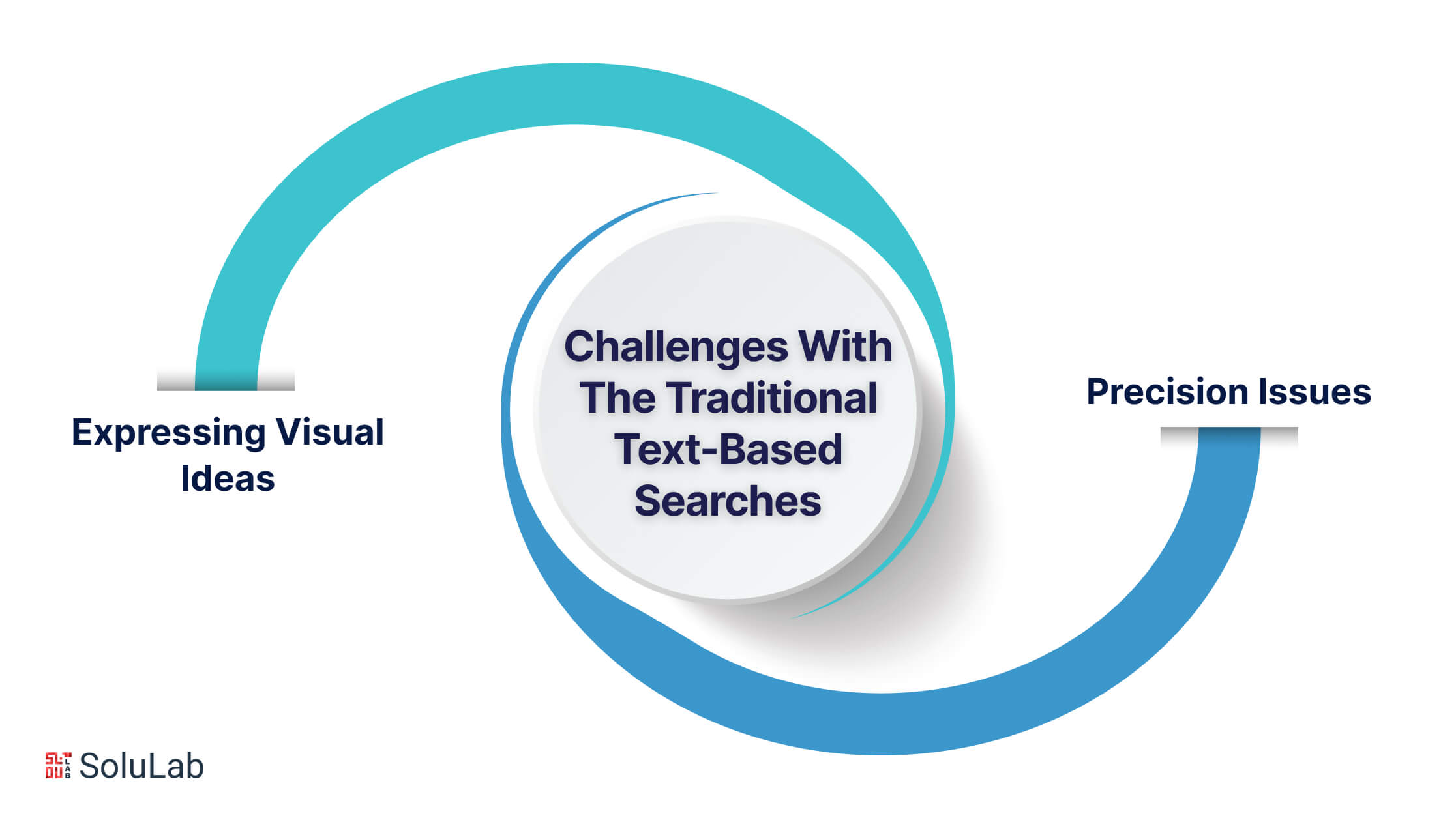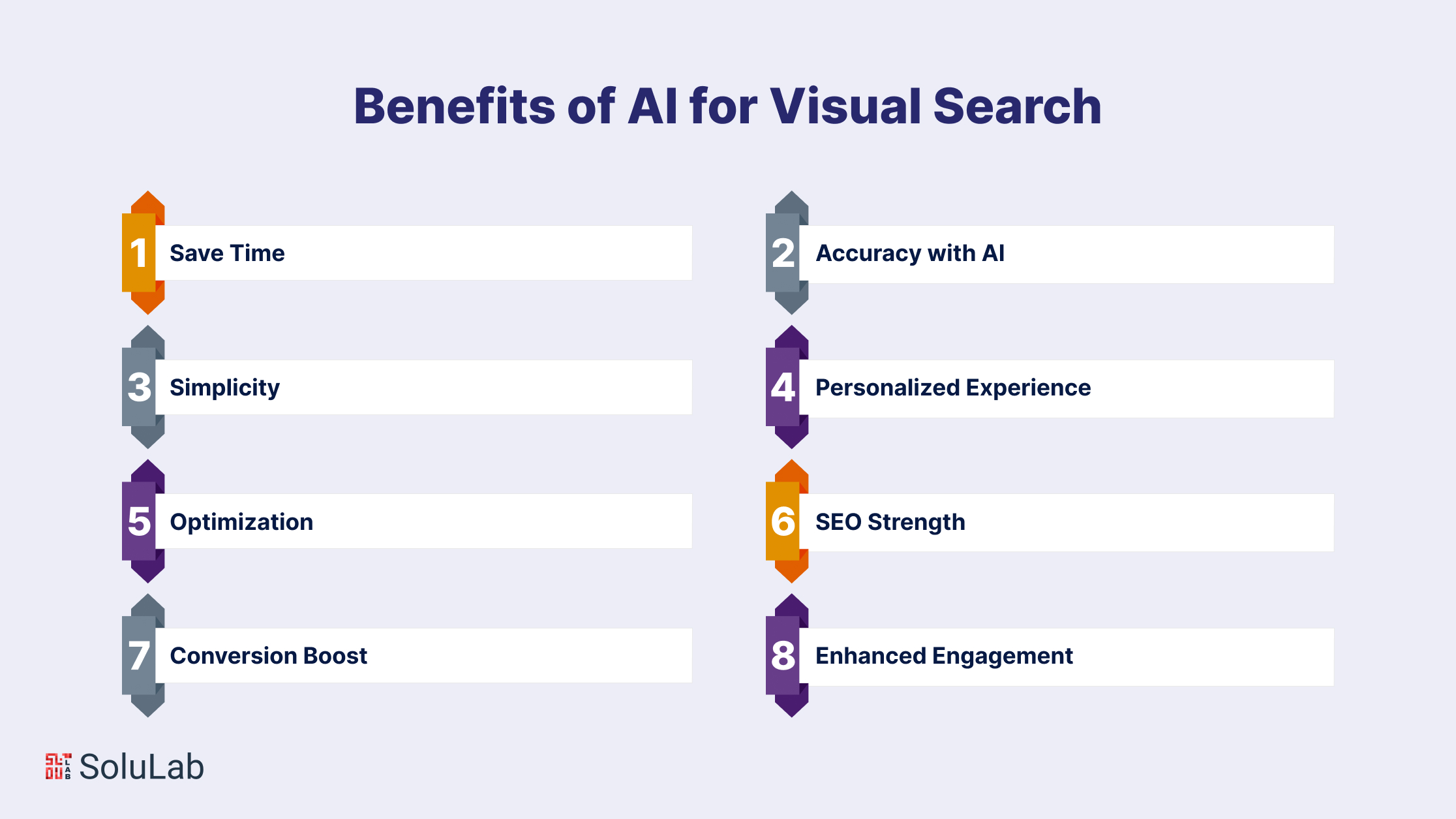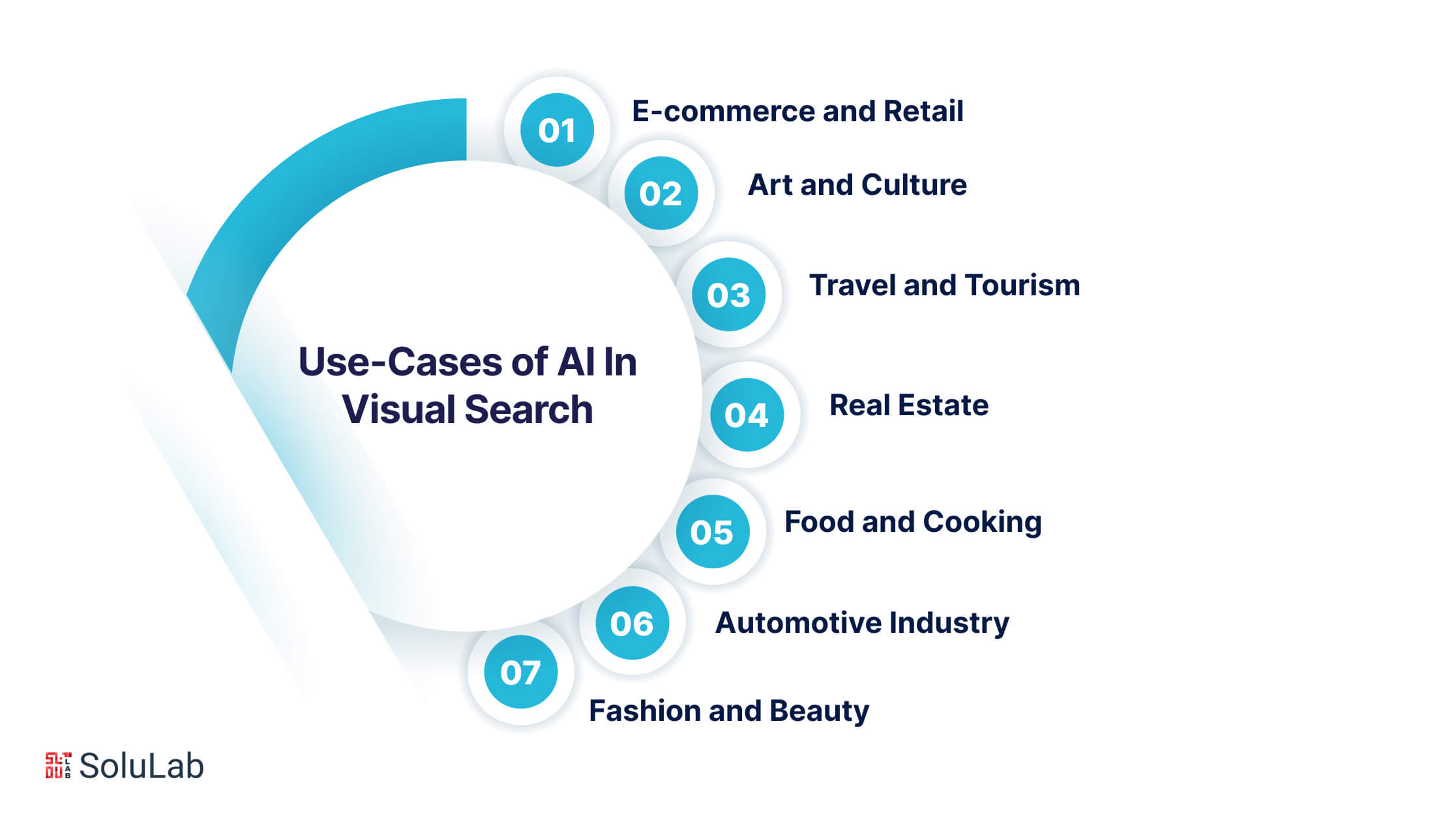Discover the transformative power of AI in visual search! Elevate your online experience with SoluLab's AI solutions. The post AI in Visual Search appeared first on Blockchain Technology, Mobility, AI and IoT Development Company USA, Canada.

In a world where everything is connected and always changing, visual search is gaining wide popularity. Itís not just about making life more convenient; itís like having a superpower that completely changes the way we look at and understand things.
Imagine this: youíre in a foreign place, and you come across a sign or a menu that you canít understand. Take a picture, and suddenly, not only do you get translations, but you also get a much better understanding of whatís going on. Or picture this: youíre on the hunt for your dream home, and all you need are pictures that inspire you. Snap them, and boom, youíre flooded with options. And what if every meal you eat could tell you about its nutrition just by taking a photo? Thatís the amazing world of visual search powered by AI, turning your camera into a magical tool for learning and exploring.
Now, letís talk about shopping. Instead of typing words to find what you want online, just point your camera at things you like. No need for fancy words or text searches. This is a game-changer in retail and online shopping.
This visual product search not only makes shopping easier but also connects the real world with the digital one. Itís like a bridge between what you see in the store and whatís available online. And guess what? Itís becoming a normal way to search.†
So, in this article, weíre going to dive into the fantastic world of visual search powered by AI. Weíll uncover how it works, why itís such a big deal, and how itís changing the way we live. Get ready for a journey into the visual future!
AI In Visual Search- An Introduction†
Visual search is like having a smart assistant that uses AI to look at real pictures, whether itís a photo you take with your phone or something you find on the internet. Itís like having a virtual guide for your online searches.
So, hereís the cool part: when you use visual search, it doesnít just show you random stuff. It actually suggests things that are related to what youíre looking for, making your search not just interesting but also really precise. And guess what makes it work so well? Itís the power of Artificial Intelligence (AI). AI helps understand the context and makes these visual searches super accurate. Itís like having a high-tech friend that knows exactly what youíre looking for!
Letís understand it with an example: you spot a celebrity wearing a fantastic dress, and you want to find something similar. Instead of struggling with words on a search engine, just upload a picture or take a screenshot. Itís that easy!†
But, Why AI In Visual Search?
AI is changing how businesses understand customers. Many big retailers now have their own picture search tools, and major brands are investing in them too. This is making the shopping experience better for everyone.
Other stores are also starting to use similar tools. They want to help customers easily find products by showing them pictures of things they might like. This not only increases the chances of selling stuff but also makes customers happy and more likely to come back and shop again.
AI image search is not just for stores. Itís also used in construction and defense. The way it works is simple: when you look for a picture, the system looks at each tiny dot in the image and compares it to dots in other pictures. The best match is then shown to you. With people often short on time to search through products, visual search is a great way for stores to connect with customers. It helps customers quickly find what they want without spending a lot of time looking for it.
Technologies Used In Visual Research†
Computer Vision
Computer vision is crucial for visual product search. It equips algorithms to understand the visual aspects of images as humans do. This tech recognizes product attributes such as shape, color, texture, and patterns. It helps accurately identify and match products in large catalogs, making the shopping experience seamless and intuitive.
Image Recognition
Image recognition algorithms quickly identify and categorize objects in images, learning from extensive datasets. They discern unique attributes that set products apart, efficiently matching user queries with relevant items. This streamlines product discovery based on visual features, speeding up the shopping process.
Deep Learning
Deep learning dissects images into meaningful features, identifying product attributes like shape and texture. Layers of analysis extract intricate details, allowing precise matching of user-generated visual queries with relevant products. This enhances the discovery of desired items, improving the overall shopping experience.
Neural Networks
Neural networks, especially Convolutional Neural Networks (CNNs), mimic human visual processing. They unravel complex images by learning intricate patterns, textures, and shapes. This enables accurate classification and understanding of images, helping discern product attributes in user-uploaded images. Neural networks facilitate precise identification and matching of products in extensive catalogs.
Natural Language Processing (NLP)
NLP techniques, when combined with visual search, enhance the interpretation of textual information linked to images. This contributes to creating precise descriptions and contextual metadata. By training neural networks to understand relationships between image content and accompanying text, the system generates more accurate product descriptions. Users can better comprehend and connect with products in search results, ultimately improving the effectiveness of visual product search.
Challenges With The Traditional Text-Based Searches

Regular text searches often struggle because words can have different meanings or interpretations. This can result in irrelevant search results, especially when people are looking for specific information or products. This makes the search process less efficient. Additionally, traditional text searches face other problems, including:
Expressing Visual Ideas: Describing visual concepts in words is hard for text searches. People looking for inspiration or trying to identify objects may find it challenging to convey their intent through text alone. This makes the search less effective. Precision Issues: Spelling mistakes, synonyms, and language differences can affect the precision of text queries. These issues make it hard for users to find exactly what theyíre looking for, causing frustration during the search.Visual Product Search As a Solution
Visual search, powered by Artificial Intelligence (AI), changes how we find things online. Instead of typing complex searches, you can just upload a picture, making the process faster. This is great for getting quick results in todayís fast-paced digital world.
AI is crucial for making visual search work well. Itís good at understanding images, giving you accurate results. This means youíre more likely to find exactly what youíre looking for, improving your experience.
Here are some Benefits of AI for Visual Search in simpler terms:

†
Save Time: Visual search emerges as a time-saving marvel in the digital landscape, eliminating the need for the laborious typing of intricate search queries. In an era where speed is of the essence, visual search streamlines the search process, allowing users to obtain rapid results by simply presenting an image. This simplicity not only accelerates the search experience but also aligns with the demands of our fast-paced, digitally-driven world. Accuracy with AI: The integration of Artificial Intelligence amplifies the precision of visual search by ensuring a profound understanding of images. AI algorithms meticulously analyze visual data, leading to more accurate and relevant search outcomes. This heightened accuracy significantly enhances the user experience, ensuring that the results align closely with the userís intent, thereby maximizing the utility of visual search. Simplicity: Visual search transcends the limitations of language, enabling users to express themselves visually without the need for elaborate textual descriptions. This simplicity is particularly advantageous when language proves insufficient or acts as a barrier. As a result, Ai using visual search appeals to a diverse user base, fostering inclusivity and accessibility in the realm of online search. Personalized Experience: One of the standout benefits of visual search lies in its capacity to learn and adapt to user preferences, providing a tailored and personalized search experience. The AI behind visual search analyzes user behavior and interactions, refining search results based on individual preferences. This personal touch extends beyond the search function, with retailers leveraging visual search to recommend products that align with a userís unique tastes. Whether through personalized emails or during interactions with the shopping cart, this customization elevates the overall user experience. Optimization: Visual search contributes to the optimization of the online shopping journey by simplifying the process for customers. By allowing users to visually explore products, it facilitates a seamless experience, reducing friction in the path to purchase. This optimization is instrumental in enhancing the overall shopping experience, increasing customer satisfaction, and reducing the likelihood of cart abandonment. SEO Strength: Integrating visual search into a website enhances its user-friendliness and search engine optimization (SEO). By catering to customers who already have a clear idea of what they want, visual search eliminates the complexities associated with traditional keyword-based searches. This streamlined approach makes the site more user-friendly and increases its visibility on search engines, contributing to improved SEO strength. Conversion Boost: Visual search has demonstrated its efficacy in boosting conversion rates and user engagement on eCommerce platforms. By simplifying the process of locating desired products, visual search ensures a quicker and more efficient customer journey. This expedited path to purchase not only enhances customer satisfaction but also translates into tangible increases in conversion rates and engagement metrics. Enhanced Engagement: Visual search doesnít just expedite the search process; it also enhances user engagement through a visually immersive experience. The interactive and dynamic exploration of products captivates users, fostering a deeper connection with the content. This heightened engagement not only retains user interest but also contributes to a more enjoyable and effective online shopping experience. As users actively participate in the visual search process, the overall interaction becomes more meaningful and memorable.Popular Brands Using AI In Visual Search†
1. ASOS, a global fashion retailer, employs AI in its virtual try-on experiences, allowing customers to virtually test clothing and accessories before purchasing. The technology analyzes facial features and body proportions, providing an accurate try-on experience, boosting customer trust, and reducing returns.
2. Pinterest Lens, introduced in 2017, has become a popular visual search tool with over 600 million monthly searches. Users can snap photos of items, and the app recognizes over 2.5 billion products, allowing users to find, save, or shop for them. Advertisers can use ďshop the lookĒ pins, enabling users to identify and research products within images. Pinterest Lens influences 90% of usersí purchasing decisions, making it a valuable tool for fashion brands and retailers.
3. Bing Visual Search, different from Pinterest Lens, provides information as well as products. When shopping intent is detected, it offers users associated products and pricing information. Developers prefer Bingís extensive platform, allowing them to define user actions based on specific image information.
4. Snapchat Camera Search, introduced in 2018, enables users to search for Amazon products by recognizing barcodes. Once a barcode is detected, users receive an Amazon card with a link to the product or similar items. Snapchatís collaboration with Amazon enhances the shopping experience.
5. Amazon StyleSnap, launched in 2019, is a visual search app integrated with Instagram. Users can take pictures of desired products within Amazonís mobile app, receive relevant information, and find similar products. For sellers on Amazon, StyleSnap provides an additional avenue to reach consumers in a competitive market.
6. Google Lens, launched in 2017, is a widely used visual search platform available in various applications for Android users. It excels in advanced AI using visual search capabilities, allowing users to combine multiple apps seamlessly. In 2019, a study found Google Lens to have more accurate image recognition technology than other major visual search platforms.
7. Shopify leverages Visual AI for automated product tagging. This technology recognizes and categorizes items, ensuring accurate product descriptions and enhancing search relevance. It streamlines inventory management, improving the overall efficiency of online marketplaces.
8. Ikea uses Visual AI-powered augmented reality apps, enabling customers to visualize furniture and decor in their homes via smartphones or tablets. This technology overlays virtual objects onto real backgrounds, helping customers make confident and accurate purchase decisions.
9. Etsy employs content moderation with AI algorithms to automatically detect and remove inappropriate content. This ensures compliance with community guidelines, fostering positive online environments and creating safe spaces for users.†
AI In Visual Search: Real-Life Use-Cases

1. E-commerce and Retail
Product Discovery: Shoppers can easily find items by taking a photo, as the system quickly identifies similar products from a vast collection. This simplifies the search, helping users discover items aligned with their preferences effortlessly. Outfit Matching: AI visual search allows users to upload outfit images, getting suggestions for similar clothing and accessories. This feature makes fashion exploration and coordination more accessible, simplifying the recreation of preferred looks. Home Decor: Users can capture images of furniture or decor they want to buy, and the system quickly identifies corresponding items online. This provides a convenient way to discover and acquire pieces that match their interior design preferences.2. Art and Culture
Artwork Identification: Visual search makes it easy to identify paintings or sculptures. Users can take photos, and the system promptly provides details like the artistís name and historical context, enriching art exploration for enthusiasts. Museum Tours: Enhancing museum experiences, visual search allows users to capture photos of artworks or artifacts, swiftly accessing relevant information. This technology deepens understanding and appreciation for the historical and artistic significance of exhibits.3. Travel and Tourism
Landmark Recognition: Travelers can engage with landmarks using visual search, obtaining details and historical context by capturing photos. This enriches the travel experience, allowing a deeper connection with surroundings and insights into cultural and historical significance. Translation and Localization: Visual search aids language translation. Users can photograph foreign signs or documents, and the system delivers accurate translations, fostering cross-cultural understanding and communication in unfamiliar environments.4. Real Estate
Property Search: Visual search revolutionizes home hunting. Potential buyers can capture images of houses or neighborhoods to swiftly access property listings, streamlining the search for their dream home. Interior Design: Visual search helps users furnish spaces by offering tailored suggestions for furniture and decor. This technology facilitates informed decisions about enhancing living environments.5. Food and Cooking
Nutritional Analysis: Individuals can monitor nutritional intake by taking pictures of meals using a visual search. Image recognition estimates nutritional content, providing insights for informed decisions about eating habits and health goals. Grocery Shopping Assistance: Users can create visual shopping lists by taking photos of items, and the system identifies them, helping navigate the store efficiently and streamlining the shopping process.6. Automotive Industry
Car Recognition: Visual search streamlines car shopping. Users capture pictures of vehicles to gather comprehensive information about make, model, features, and pricing, facilitating more informed decisions. Parts Identification: In automotive maintenance, visual search helps identify car parts accurately. This streamlines sourcing replacement parts for mechanics and car enthusiasts, enhancing efficiency in repairs and customization projects.7. Fashion and Beauty
Cosmetic Recommendations: Visual search offers personalized beauty guidance. By taking selfies, users receive tailored product recommendations based on complexion, style, and preferences, enhancing the cosmetic shopping experience. Hairstyle Ideas: It provides a novel approach to hairstyle inspiration. By uploading photos, users get tailored suggestions considering factors like hair type and face shape, offering valuable insights for exploring new looks.Future Of AI In Visual Search†
The future of AI in visual search is going to bring even better improvements in how computers understand human language. This means that when you search for something, the results will be more accurate and tailored to what youíre looking for.†
For exampleĖ Google is working on a search engine called Bard AI that lets you ask complex questions in a natural, conversational way, making searches more effective.
Looking ahead, we can expect search results to become faster and more tailored to what each person likes. AI will analyze how people search and what they prefer, delivering better and more personalized results in real-time. Thereís a trend called ďzero-click searchesĒ where the answer is given right away, so users donít need to visit a website. While this is convenient, it might reduce the number of people visiting websites, and businesses will need to think about this when planning how to reach their audience.
Conclusion
In the fast-changing tech world, AI using visual search is a big step forward that can change how we use information. Its skill in understanding the visual world adds excitement to our online adventures. Visual product search creates fresh ways to find things, solve problems, and get involved, letting us explore using pictures. As this tech grows and becomes a part of our daily lives, itís bound to make a big impact on industries, how we interact with tech, and how we move around in our digital world.
The advent of visual search technology presents a unique opportunity to enhance your mobile app, boosting user experience and giving you a competitive edge.
SoluLab,†is well-versed in seamlessly integrating visual search technology into mobile apps across various industries. No matter if youíre in beauty, fashion, or real estate, we can assist you in adding visual search features to your apps.†Hire developers from our team for strong AI development solutions based on visual search. These solutions enable your customers to find and explore products, information, and content by using pictures instead of text.
FAQs†
1. What is visual search in AI?
Visual search in AI involves using images instead of text to find information. It allows users to search for similar or related items by providing images as input, enabling a more intuitive and user-friendly search experience.
2. How does AI enhance visual search capabilities?
AI enhances visual search by leveraging advanced algorithms to analyze and recognize patterns, shapes, and features within images. This enables the system to understand and process visual data, providing more accurate and relevant search results.
3. Can AI-powered chatbot visual search be used for e-commerce?
Yes, AI-powered chatbot visual search is highly valuable for e-commerce. It enables users to find products by uploading images, making the shopping experience more efficient and enjoyable. This technology enhances product discovery and reduces the reliance on text-based searches.
4. What challenges does AI face in visual search?
AI in visual search faces challenges like accurately interpreting complex images, handling variations in lighting and perspective, and ensuring robustness against diverse visual data. Ongoing advancements aim to address these challenges and improve overall performance.
5. How is AI impacting image recognition in visual search?
AI significantly improves image recognition in visual search by continuously learning and refining its understanding of visual content. This enables systems to recognize objects, scenes, and even specific details within images, enhancing the accuracy and efficiency of visual searches.
6. Are there privacy concerns with AI in visual search?
Yes, privacy concerns exist in AI-powered visual search. Issues may arise when personal or sensitive images are inadvertently included in searches. AI developers must implement strong privacy measures, ensuring that user data is handled responsibly and ethically.
7. Can AI in visual search be integrated with other technologies?
Yes, AI in visual search can be seamlessly integrated with other technologies. Combining it with augmented reality (AR) or natural language processing (NLP) can create more immersive and interactive experiences. Such integrations open up new possibilities for industries like retail, education, and healthcare.
The post AI in Visual Search appeared first on Blockchain Technology, Mobility, AI and IoT Development Company USA, Canada.




